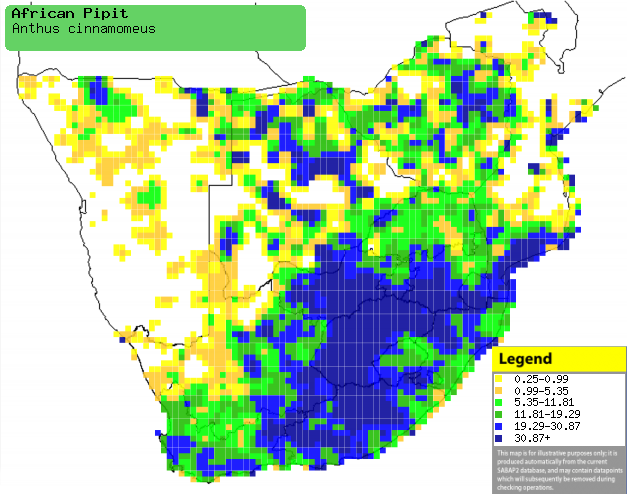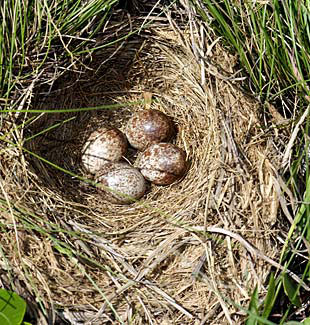|
Anthus cinnamomeus (African
pipit, Grassveld pipit)
Gewone koester [Afrikaans]; Icelu, Icetshu (generic terms
for pipit) [Xhosa]; umNgcelekeshu, umNgcelu (generic terms for pipit)
[Zulu]; Tšase (generic term for pipit), Tšaase-ea-lithota [South Sotho];
Kaneelpieper [Dutch]; Pipit africain [French]; Weidelandpieper,
(Spornpieper) [German]; Petinha-do-capim [Portuguese]
Life
> Eukaryotes >
Opisthokonta
> Metazoa (animals) >
Bilateria >
Deuterostomia > Chordata >
Craniata > Vertebrata (vertebrates) > Gnathostomata (jawed
vertebrates) > Teleostomi (teleost fish) > Osteichthyes (bony fish) > Class:
Sarcopterygii (lobe-finned
fish) > Stegocephalia (terrestrial
vertebrates) > Tetrapoda
(four-legged vertebrates) > Reptiliomorpha > Amniota >
Reptilia (reptiles) >
Romeriida > Diapsida > Archosauromorpha > Archosauria >
Dinosauria
(dinosaurs) > Saurischia > Theropoda (bipedal predatory dinosaurs) >
Coelurosauria > Maniraptora > Aves
(birds) > Order: Passeriformes
> Family: Motacillidae > Genus: Anthus
Distribution and habitat
Occurs from the south-west of the Arabian peninsula through
Ethiopia, southern Sudan, Tanzania, Angola and Zambia to southern Africa. Here
it is common across much of the region excluding arid areas of Namibia,
south-western Botswana and western South Africa. It generally prefers moist
grassland, lightly wooded savanna, dry flood plains, recently burnt grassland,
roadsides, playing fields and agricultural land.
|
 |
|
Distribution of African pipit in southern Africa,
based on statistical smoothing of the records from first SA Bird Atlas
Project (©
Animal Demography unit, University of
Cape Town; smoothing by Birgit Erni and Francesca Little). Colours range
from dark blue (most common) through to yellow (least common).
See here for the latest distribution
from the SABAP2. |
Predators and parasites
It has been recorded as prey of the following animals:
Movements and migrations
It is though to be mainly resident however in
the non-breeding season it may be nomadic, traveling in search of
areas which have experience recent rainfall.
Food
It mainly eats insects and other arthropods, doing most of
its foraging the ground, sifting through debris in search of food and
occasionally hawking prey aerially. The following food items have been recorded
in its diet:
Breeding
- Monogamous, solitary nester, with each male defending his territory by
going upwards in a deeply undulating flight while singing.
- The nest (see image below) is built by mainly or solely by the female in
at least 3-4 days, consisting of a neat cup made of dry grass and root
stubble and lined with fine rootlets, hair and fibres. It is typically
placed in a shallow depression in the ground at the base of a grass tuft or
shrub, often on a sloping bank close to an open space or path.
 |
|
|
African pipit nest with eggs, Wakkerstroom area,
South Africa. [photo Warwick Tarboton ©] |
|
- Egg-laying season is year-round, peaking from August-May.
- It lays 1-4, rarely 5 eggs, which are incubated by both sexes for about
13-14 days.
- The chicks are initially brooded by the female and fed by both parents,
leaving the nest after about 11-17 days, but remaining in the vicinity of
the nest for longer, still reliant on the adults for food. If a predator
approaches the young their parents attempt to lure it away from their brood
by pretending to have a broken wing.
Threats
Not threatened, in fact it has benefited from agriculture
and other human endeavours.
References
-
Hockey PAR, Dean WRJ and Ryan PG 2005. Roberts
- Birds of southern Africa, VIIth ed. The Trustees of the John Voelcker
Bird Book Fund, Cape Town.
|
